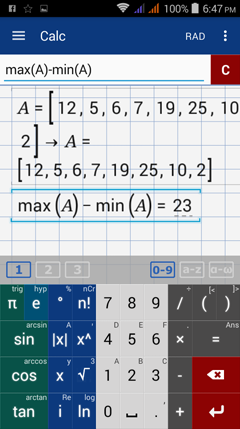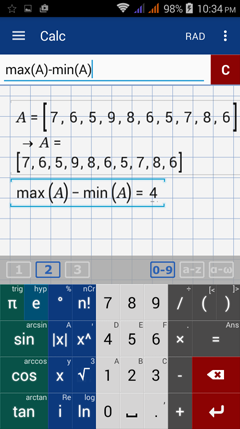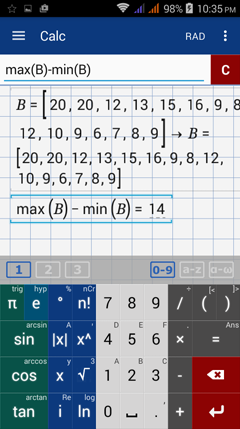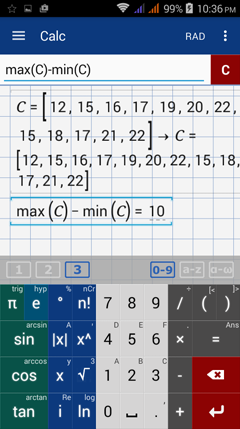19.6.1. Range
Range refers to the difference between the minimum and maximum values of a data set while the interquartile range (IQR) is the difference between the 3rd and 1st quartiles, the 1st quartile at the 25th percentile and the 3rd at the 75th percentile. IQR is the range of the middle 50% of the values.
Finding the Range
To find the range of a data set, subtract the minimum and maximum values. Enter the data set in matrix form and use the command max(A) - min(A). Note: A is an arbitrary name for the first matrix, but you can use any capital letter.
Illustrative Example
Find the range of the data set: 12, 5, 6, 7, 19, 25, 10, 2
Solution
Enter data set as a matrix.
A = [12, 5, 6, 7, 19, 25, 10, 2]
Use the syntax: max(A) - min(A)
The range of the data set is 23.
Finding the Range
To find the range of a data set, subtract the minimum and maximum values. Enter the data set in matrix form and use the command max(A) - min(A). Note: A is an arbitrary name for the first matrix, but you can use any capital letter.
Illustrative Example
Find the range of the data set: 12, 5, 6, 7, 19, 25, 10, 2
Solution
Enter data set as a matrix.
A = [12, 5, 6, 7, 19, 25, 10, 2]
Use the syntax: max(A) - min(A)
The range of the data set is 23.
Examples
Find the range of each data set below.
1) The shoe sizes of ten people in a survey are: 7, 6, 5, 9, 8, 6, 5, 7, 8, 6.
2) The math scores of 15 students (out of 20) are: 20, 20, 12, 13, 15, 16, 9, 8, 12, 10, 9, 6, 7, 8, 9.
3) The ages of 12 students at a gathering are: 12, 15, 16, 17, 19, 20, 22, 15, 18, 17, 21, 22.
Calculator solutions
1) Enter the data set using a matrix by tapping the following keys in order:
A = [7, 6, 5, 9, 8, 6, 5, 7, 8, 6]
Hold the factorial (n!) key and select max, then type: A ) and enter a minus. It should appear as max(A).
Hold the factorial (n!) key again and this time select min. Then type: A ) and hit enter. It should appear as min(A).
max(A) - min(A)
Find the range of each data set below.
1) The shoe sizes of ten people in a survey are: 7, 6, 5, 9, 8, 6, 5, 7, 8, 6.
2) The math scores of 15 students (out of 20) are: 20, 20, 12, 13, 15, 16, 9, 8, 12, 10, 9, 6, 7, 8, 9.
3) The ages of 12 students at a gathering are: 12, 15, 16, 17, 19, 20, 22, 15, 18, 17, 21, 22.
Calculator solutions
1) Enter the data set using a matrix by tapping the following keys in order:
A = [7, 6, 5, 9, 8, 6, 5, 7, 8, 6]
Hold the factorial (n!) key and select max, then type: A ) and enter a minus. It should appear as max(A).
Hold the factorial (n!) key again and this time select min. Then type: A ) and hit enter. It should appear as min(A).
max(A) - min(A)
2) Enter the data set using a matrix by tapping the following keys in order:
B = [20, 20, 12, 13, 15, 16, 9, 8, 12, 10, 9, 6, 7, 8, 9]
Hold the factorial (n!) key and select max, then type: B ) and enter a minus. It should appear as max(B).
Hold the factorial (n!) key again and this time select min. Then type: B ) and hit enter. It should appear as min(B)
max(B) - min(B)
3) Enter the data set using a matrix by tapping the following keys in order:
C = [12, 15, 16, 17, 19, 20, 22, 15, 18, 17, 21, 22]
Hold the factorial (n!) key and select max, then type: C ) and enter a minus. It should appear as max(C).
Hold the factorial (n!) key again and this time select min. Then type: C ) and hit enter. It should appear as min(C).
max(C) - min(C)





